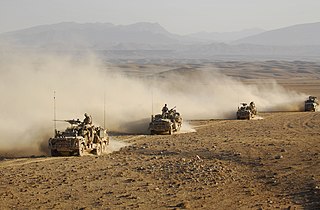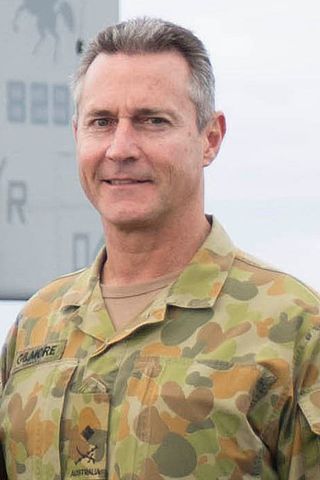
A technical, officially a non-standard tactical vehicle (NSTV) in United States military parlance, is a light improvised fighting vehicle, typically an open-backed civilian pickup truck or four-wheel drive vehicle, mounting a machine gun, anti-aircraft autocannon, rotary cannon, anti-tank weapon, anti-tank gun, ATGM, mortar, multiple rocket launcher, recoilless rifle, or other support weapon.

The Special Air Service Regiment, officially abbreviated SASR though commonly known as the SAS, is a special forces unit of the Australian Army. Formed in 1957, it was modelled on the British SAS sharing the motto, "Who Dares Wins". The regiment is based at Campbell Barracks, in Swanbourne, a suburb of Perth, Western Australia, and is a direct command unit of the Special Operations Command. It has taken part in operations in Borneo, Vietnam, Somalia, East Timor, Iraq and Afghanistan, as well as many other peacekeeping missions. The SASR also provides a counter-terrorist capability, and has been involved in a number of domestic security operations.

Australia joined a US-led coalition in its 2003 Iraq invasion. Declassified documents reveal that the decision to go to war was taken primarily with a view to enhancing its alliance with the United States.

The Australian contribution to the war in Afghanistan has been known as Operation Slipper (2001–2014) and Operation Highroad (2015-2021).

The 1st New Zealand Special Air Service Regiment, abbreviated as 1 NZSAS Regt, was formed on 7 July 1955 and is the special forces unit of the New Zealand Army, closely modelled on the British Special Air Service (SAS). It traces its origins to the Second World War and the famous Long Range Desert Group that New Zealanders served with.

The Bushmaster Protected Mobility Vehicle or Infantry Mobility Vehicle is an Australian-built four-wheel drive armoured vehicle. The Bushmaster was primarily designed by the then government-owned Australian Defence Industries (ADI), and is currently produced by Thales Australia following their acquisition of ADI. The Bushmaster is currently in service with the Australian Army, Royal Australian Air Force, Royal Netherlands Army, British Army, Japan Ground Self Defense Force, Indonesian Army, Fiji Infantry Regiment, Jamaica Defence Force, New Zealand Army and the Armed Forces of Ukraine.

Forsvarets Spesialkommando (FSK) is a special operations forces unit of the Norwegian Special Operation Forces. The unit was established in 1982 due to the increased risk of terrorist activity against Norwegian interests, including the oil platforms in the North Sea.

The Special Forces Support Group (SFSG) is a special forces unit of the British Armed Forces. The SFSG was formed officially on 3 April 2006 to provide support to the Special Air Service, the Special Boat Service and the Special Reconnaissance Regiment on operations. It is a tri-service unit, composed of the 1st Battalion, The Parachute Regiment, and a company of Royal Marine Commandos and A flight (platoon) from the RAF Regiment.

The special forces of the Australian Defence Force are units of Special Operations Command and associated units of the Royal Australian Navy and the Royal Australian Air Force that conduct and or support special operations to advance and protect the national security of the Commonwealth of Australia. The special forces of Australia have a lineage to a variety of units raised in the Second World War such as the Independent and Commando Companies, Z Special Unit, Navy Beach Commandos, and the Coastwatchers. Australian special forces have most recently been deployed to Iraq in Operation Okra as the Special Operations Task Group, as the Special Operations Task Group in Afghanistan, in Afghanistan in support of the Australian Secret Intelligence Service and regularly for counter-terrorism pre-deploy to locations of major domestic events throughout Australia in readiness to support law enforcement such as the 2014 G20 Brisbane summit.

The Snatch Land Rover is a protected patrol vehicle based on the Land Rover Defender 110 chassis. Intended for general patrolling in low-threat areas, the vehicle was developed in 1992 for use in Northern Ireland. It provides a limited degree of small arms protection for occupants and a limited level of protection from Improvised Explosive Devices and off-route mines.

The Jackal or MWMIK is a family of vehicles designed and developed by Supacat Ltd at their factory in Honiton, Devon, UK, for use by the British Army and Royal Air Force Regiment.

The Land Rover Perentie is a nickname for the Land Rover 110 produced by JRA Limited for the Australian Army, and part manufactured and assembled in Moorebank, New South Wales, during the 1980s and 1990s. There were two build contracts; the first was in 1988 and the second a decade later. The Perentie was based on the Land Rover Defender 110, and was introduced in 1987 to replace the ageing fleet of Series 2A and 3 Land Rovers.

Mark Gregor Strang Donaldson, is an Australian soldier and a recipient of the Victoria Cross for Australia, the highest award in the Australian honours system. Then Trooper Donaldson was a member of the Special Air Service Regiment (SASR) when he exposed himself to enemy fire to protect injured troops and then rescued an interpreter under heavy enemy fire in the Battle of Khaz Oruzgan during Operation Slipper, the Australian contribution to the War in Afghanistan. He was presented with the decoration by the Governor-General of Australia, Quentin Bryce, in a ceremony in Canberra on 16 January 2009. On 25 January 2010, Donaldson was named the 2010 Young Australian of the Year. He was promoted to corporal in June 2010.

The 2nd Commando Regiment is a special forces unit of the Australian Army and is part of Special Operations Command. The regiment was established on 19 June 2009 when the 4th Battalion RAR (Commando) was renamed. It is based at Holsworthy, New South Wales. The 2nd Commando Regiment trains and has served with coalition special forces units, and is highly regarded by these units. The regiment has been involved in operations in East Timor, Iraq and Afghanistan, where it was used in a direct action warfighting role. It has also been involved in domestic security operations including the 2006 Commonwealth Games and the 2014 G20 Leaders Summit. In 2019, the regiment was made the Command's capability lead for strategic strike.

Matthew Raymond Locke, MG was an Australian soldier and a recipient of the Medal for Gallantry, the third highest award for wartime bravery in the Australian honours system. During Operation Spin Ghar, with his patrol entrusted with setting up an observation post in Tarin Kowt, Oruzgan province, the patrol was compromised by militia after a 10-hour foot infiltration up the side of a mountain. Sergeant Locke, without regard for his own personal safety, led a two-man team to neutralise the Anti-Coalition Militia in order to protect the patrol from being overrun, and in effect repeatedly exposed himself to intense rifle and machine gun fire. He was awarded the medal in December 2006. Sergeant Locke was on patrol in October 2007 when he was fatally shot by small arms fire from militia.

The Force Protection Ocelot is a British armoured vehicle that replaced the United Kingdom's Snatch Land Rover with British forces. It received the service name Foxhound, in line with the canine names given to other wheeled armored vehicles in current British use such as Mastiff, Wolfhound, and Ridgeback, which are all variants of the Cougar.

Major General Peter Warwick "Gus" Gilmore, is a retired senior officer of the Australian Army. A graduate of the Royal Military College, Duntroon, he was commissioned into the Royal Australian Infantry Corps in 1983 and spent much of his career in special forces. He commanded the Special Air Service Regiment (2001–02), led the first contingent of the Australian Special Operations Task Group in Afghanistan (2001–02), was responsible for the Coalition Advisory Support Team in Iraq (2005–06), and commanded International Security Assistance Force Special Operations Forces (2009–10). Following promotion to major general he held a succession of senior appointments, including Special Operations Commander Australia (2011–13), Deputy Chief of Army (2013–15), and Commander Forces Command (2015–16). His final appointment was as Head Military Strategic Commitments Division from 2016 to 2019.

The Battle of Khas Oruzgan occurred when a combined Australian, American, and Afghan patrol was ambushed by up to 200 Taliban fighters near the village of Khaz Oruzgan. The infamous battle was one of the most intense for Australian forces since the Vietnam war at the time.

SC Group is a British multi-faceted engineering company which prior to a re-brand in September 2015 was known as Supacat Limited. Supacat was established in 1981 and based at Dunkeswell Aerodrome in England. SC Group now comprises four companies: Supacat, SC Innovation, Proteum and Blackhill Engineering.
Operation Trent was an operation by Special Air Service (SAS) elements of the British Army, the largest known post-WWII operation in SAS history. Tony Blair had requested that the SAS be allowed an operation. The operation was carried out by members of a regimental task group, made up of a tactical HQ, members of A Squadron and G Squadron of the 22nd Special Air Service Regiment, supported by United States (US) forces, on an al-Qaeda-linked opium plant during the 2001 invasion of Afghanistan at the start of Operation Enduring Freedom – Afghanistan (OEF-A).




















